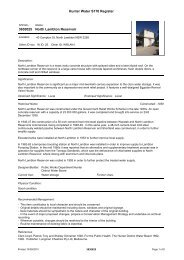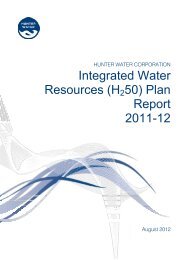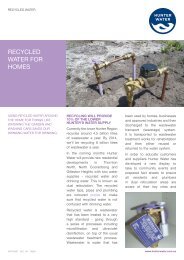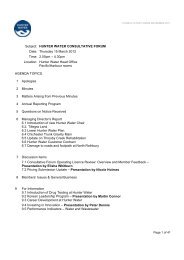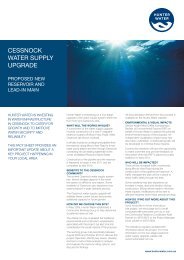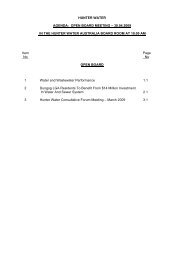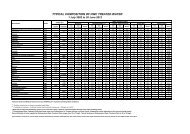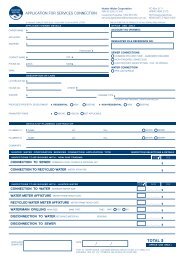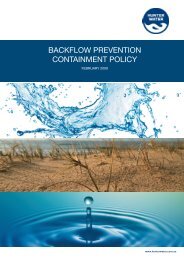Catchment Management Plan - Hunter Water
Catchment Management Plan - Hunter Water
Catchment Management Plan - Hunter Water
You also want an ePaper? Increase the reach of your titles
YUMPU automatically turns print PDFs into web optimized ePapers that Google loves.
3. It is built on a platform that isscientifically robust, easily updatedand takes a logical approach todecision making;4. It has a practical output that will beable to be used in decision making byspecialists and non-specialists alike;5. IPART are familiar with the model andtheir support will be needed ifcatchment protection is to receiveincreased funding in future.<strong>Hunter</strong> <strong>Water</strong> has partnered with the SCAfor access to this model and we havebegun a demonstration run of the SWISSon the Grahamstown <strong>Catchment</strong>.3.1.3 Overview of the modelThe SWISS model graphically identifiesthe catchment areas that pose greatestrisk from pathogens (disease causingorganisms), suspended solids andnutrients (nitrogen and phosphorus). Themodel has a relatively simple structurein comparison with other quantitativecatchment models throughout Australiaand globally. However, many of the morecomplex quantitative models have to berun by specialists. The power of SWISSlies in its ability to be built, run andanalysed by catchment managers.Each component of the SWISS istransparent and able to be modifiedindependently to incorporateimprovements in inputs and assessmentmethods. The model can also be used topredict the effects of land use changesby running scenarios. This is a powerfulexploratory tool and could be used whenconsidering broad catchment planningdecisions in the future.Over the past five years ofdevelopment at the SCA, the accuracyof the model has been reviewed usingthe following methods:• Comparison with monitored datarevealed sensible results;• Expert panels agreed with theoutputs;• Public consultation on methods wasfavourable (2007);• Presentation to the international‘<strong>Water</strong> Down Under’ conference(2008) was positive;• Public consultation on results in2009 has verified that the model isproducing sensible results.As a consequence, the level ofconfidence that <strong>Hunter</strong> <strong>Water</strong> has in themodel methodology is high.3.1.4 Results of <strong>Hunter</strong> <strong>Water</strong>SWISS demonstration runThe following maps demonstrate anexample of the SWISS model output.Figures 18-20 show the first model runfor nitrogen, phosphorus and pathogenrisk from grazing in the Grahamstowncatchment.The output is built from 9 sets of data or‘layers’ such as rainfall, slope, erosivityof soils, groundcover, distance fromstreams and density of farm animals.Layers are weighted according to bestscientific understanding and overlayedupon each other. Red areas represent ahigh risk and blue are lower risk to theraw water source.In essence, the SWISS model inputsvarious spatial GIS data ‘layers’ thatcan be continuous (e.g. rainfall) or pointsource (e.g. intensive animal sheds). Themodel then uses weightings (determinedfrom expert panel workshops) to multiplythe importance of each layer to determinethe areas with greatest contribution tonutrient, turbidity and pathogen risk incatchments (Figure 17). There are variousinbuilt scripts to calculate parameterssuch as number of pathogens fromlivestock and alike. The output is aranking of activities and associated areasin the catchment that pose the greatesthazard to drinking water quality.<strong>Catchment</strong> risks may then be rankedaccording to a prioritisation processwhich factors in practical aspects suchas the cost of reducing each hazard, thelikely effectiveness of remediation worksand the level of confidence in the data.<strong>Catchment</strong> data inputs (land use,slope, erodability, rainfall, etc)Source <strong>Water</strong> ImprovementSupport System modelRanked catchment prioritiesWeightings of each inputAreas of greatest nutrient, turbidity andpathogen input in catchmentsPrioritisation process(cost, ease ofremediation, etc)Figure 17: How the SWISS ranks catchment hazard prioritiesCATCHMENT MANAGEMENT PLAN . ssS . 001 . JUNE201025




